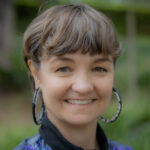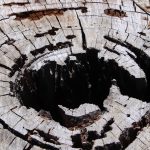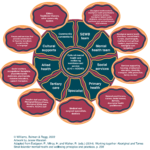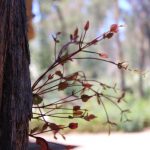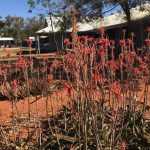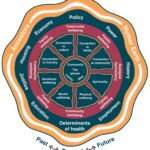
June 2023
Download The Aboriginal person’s client journey PDF
When services are being developed, the individual client journey can be overlooked, as can be the role of informal support. Yet this is the most important part of the picture.
Yulang developed this client journey while working on an Aboriginal mental health and wellbeing model of care, but it is applicable to (or adaptable to) any situation where a health service is providing care to Aboriginal and Torres Strait Islander people.
At the centre of the journey, informing every step of the way, is a holistic view of health (Williams & Ragg 2022) – see Figure 1.
Figure 1: Aboriginal people's holistic view of health

Copyright Williams, Ragg & Bulman, 2022. Artwork by Jessie Waratah
In the ideal client journey:
- the person already knows the service, because that service has engaged with community
- the person enters the service with the support of family, community and health services, without needing the emergency department, an ambulance or the police
- an Aboriginal person walks with the person throughout their journey
- the person sees a team involving, and preferably led by, Aboriginal people
- if a formal assessment tool is used, that tool is culturally validated
- the care provided is holistic and meets the worldview of the client
- care takes place in the most culturally appropriate, least restrictive, place
- care links with other services in the community
- if a referral is made, it is a warm referral
- after returning to the community, the client is followed up to ensure they receive the support they need.
See Figure 2.
Figure 2: The client journey

Copyright Williams & Ragg, 2022
This client journey is best developed by people who are actively developing their cultural responsiveness.
And note the importance of culture throughout. Cultural safety, now a legislated aspect of safety and quality in health care, is as relevant as clinical safety. A health service cannot be clinically safe if it is not culturally safe, and vice versa.
Figure 3: The equal weight of clinical safety and cultural safety

Copyright Williams & Ragg, 2022
Recommended citation
Williams, M. & Ragg, M. (2023). The Aboriginal person’s client journey. Yulang Indigenous Evaluation. https://yulang.com.au/starburst-indigenous-evaluations/client-journey/
References
Williams, M., & Ragg, M. (2022). Aboriginal mental health and wellbeing model of care. [Submitted for publication]. NSW Ministry of Health.
